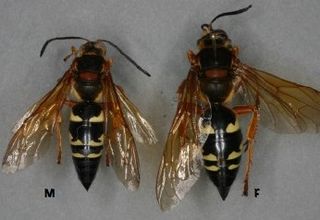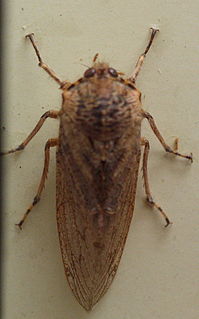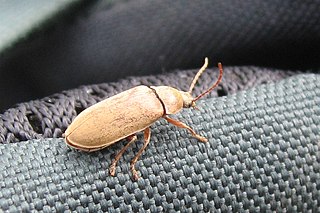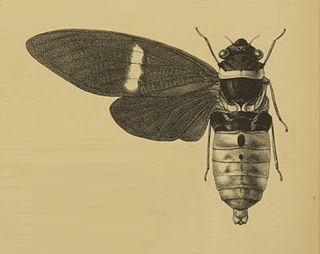
In biology, a nymph is the immature form of some invertebrates, particularly insects, which undergoes gradual metamorphosis (hemimetabolism) before reaching its adult stage. Unlike a typical larva, a nymph's overall form already resembles that of the adult, except for a lack of wings. In addition, while a nymph moults it never enters a pupal stage. Instead, the final moult results in an adult insect. Nymphs undergo multiple stages of development called instars.

Magicicada is the genus of the 13-year and 17-year periodical cicadas of eastern North America. Although they are sometimes called "locusts", this is a misnomer, as cicadas belong to the taxonomic order Hemiptera, suborder Auchenorrhyncha, while locusts are grasshoppers belonging to the order Orthoptera. Magicicada belongs to the cicada tribe Lamotialnini, a group of genera with representatives in Australia, Africa, and Asia, as well as the Americas.

Sphecius speciosus, often simply referred to as the cicada killer or the cicada hawk, is a large digger wasp species. Cicada killers are large, solitary wasps in the family Crabronidae. The name may be applied to any species of crabronid which preys on cicadas, though in North America it is typically applied to a single species, S. speciosus. However, since there are multiple species of related wasps, it is more appropriate to call it the eastern cicada killer. This species occurs in the eastern and midwest U.S. and southwards into Mexico and Central America including Louisiana. They are so named because they hunt cicadas and provision their nests with them. In North America they are sometimes called sand hornets, although they are not hornets, which belong to the family Vespidae. Cicada killers exert a measure of natural control on cicada populations and thus may directly benefit the deciduous trees upon which their cicada prey feed.

Cicadas of the genus Neotibicen are large-bodied insects of the family Cicadidae that appear in summer or early fall in eastern North America. Common names include cicada, harvestfly, jar fly, and the misnomer locust. Until recently, these species were all in the genus Tibicen, which was redefined in the twenty-first century to include only a few European species, while species from the Western United States and Mexico are now placed in a separate genus, Hadoa. In addition, several former Neotibicen species have been moved to the genus Megatibicen.

Tree trunk spiders (Hersiliidae) is a tropical and semi-tropical family first described by Tamerlan Thorell in 1870. They have two prominent spinnerets that are almost as long as their abdomen, earning them the nickname "two-tailed spiders". They range in size from 10 to 18 millimetres long. Rather than using a web that captures prey directly, they lay a light coating of threads over an area of tree bark and wait for an insect to stray onto the patch. When this happens, they encircle their spinnerets around their prey while casting silk on it. When the insect is immobilized, they can bite it through the shroud.

The Auchenorrhyncha suborder of the Hemiptera contains most of the familiar members of what was called the Homoptera – groups such as cicadas, leafhoppers, treehoppers, planthoppers, and spittlebugs. The aphids and scale insects are the other well-known "Homoptera", and they are in the suborder Sternorrhyncha. Lesser-known insects largely regarded as Homoptera are the Coleorrhyncha. However, the taxonomic status of the Hemiptera and Homoptera is currently under investigation and discussion. See Heteroptera and Prosorrhyncha for more information.

The Tettigarctidae, known as the hairy cicadas, are a small relict family of primitive cicadas. Along with more than 20 extinct genera, Tettigarctidae contains a single extant genus, Tettigarcta, with two extant species, one from southern Australia and one from the island of Tasmania. Fossil taxa include Paratettigarcta from the Miocene of New Zealand, Meuniera from the Paleocene of France, and Sanmai from the Late Jurassic of China.Tettigarcta are the closest living relatives of the true cicadas.
Cicada is a fictional character appearing in American comic books published by DC Comics.

Dascilloidea is a superfamily of polyphagan beetles, comprising two families: Dascillidae and Rhipiceridae.
Cicada lore and mythology is rich and varied as there are c. 2500 species of cicada throughout the world, many of which are undescribed and remain a mystery to science. Cicada has been prized as a delicacy, and are famed throughout the world for their song.

The Cicadinae are a subfamily of cicadas, containing the translucent cicadas. They are robust cicadas and many have gaudy colors, but they generally lack the butterfly-like opaque wing markings found in many species of the related Tibiceninae.

Magicicada cassinii, sometimes called the 17-year cicada or the dwarf periodical cicada, is a species of periodical cicada. It is endemic to the United States. It has a 17-year lifecycle but is otherwise indistinguishable from the 13-year periodical cicada Magicicada tredecassini. The two species are usually discussed together as "cassini periodical cicadas" or "cassini-type periodical cicadas." Unlike other periodical cicadas, cassini-type males may synchronize their courting behavior so that tens of thousands of males sing and fly in unison.
Ellie Mathews is an author of fiction and nonfiction works including The Linden Tree. Her recipe for Salsa Couscous Chicken was the Grand Prize Winner of the 1998 Pillsbury Bake-Off.

Thopha saccata, commonly known as the double drummer, is the largest Australian species of cicada and reputedly the loudest insect in the world. Documented by the Danish zoologist Johan Christian Fabricius in 1803, it was the first described and named cicada native to Australia. Its common name comes from the large dark red-brown sac-like pockets that the adult male has on each side of its abdomen—the "double drums"—that are used to amplify the sound it produces.

Aleeta curvicosta is a species of cicada, one of Australia's most familiar insects. Native to the continent's eastern coastline, it was described in 1834 by Ernst Friedrich Germar. As of 2014 the floury baker is the only described species in the genus Aleeta.

Sphecius grandis, also called the western cicada killer, is a species of cicada killer wasp (Sphecius). The western species shares the same nesting biology as its fellow species, the eastern cicada killer. S. grandis, like all other species of the genus Sphecius, mainly provides cicadas for its offspring. It forms nest aggregations and mates and broods once in a year, in July and early August. The wasp is on average 3 cm (1 in) to 5 cm (2 in) in length and is amber-yellow with yellow rings on its abdomen.

Cicada 3301 is a nickname given to an organization that on three occasions has posted a set of puzzles to recruit codebreakers/linguists from the public. The first internet puzzle started on January 4, 2012 and ran for approximately one month. A second round began one year later on January 4, 2013, and a third round following the confirmation of a fresh clue posted on Twitter on January 4, 2014. The stated intent was to recruit "intelligent individuals" by presenting a series of puzzles which were to be solved. No new puzzles were published on January 4, 2015. However, a new clue was posted on Twitter on January 5, 2016. In April 2017 a verified PGP-signed message was found: Beware false paths. Always verify PGP signature from 7A35090F. That message explicitly denies the validity of any unsigned puzzle, as recently as April 2017.

Tosena melanoptera is a cicada species from Southeast Asia. It was described by White in 1846 from material collected in North India. It has also been recorded from Thailand and Vietnam.

The Dundubiini are a tribe of cicadas in the family Cicadidae, found in the Palearctic, Indomalaya, Australasia, and the Western Pacific. There are at least 20 genera and 180 described species in Dundubiini.

















